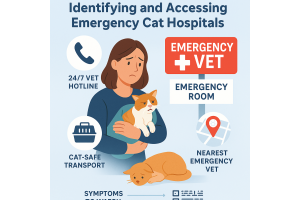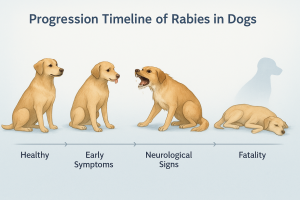Rabies in Dogs: How Long Can a Dog Live with Rabies?

Rabies in Dogs: How Long Can a Dog Live with Rabies?
Rabies is a rapidly progressing disease, and once symptoms appear, a dog’s survival time is short. Understanding the progression of rabies and how long a dog can survive with the disease is critical in preventing exposure and managing the situation if it occurs.
1. Rapid Disease Progression
Rabies progresses quickly once clinical symptoms appear, and a dog can deteriorate within days.
- Incubation Period: Before symptoms show, the dog may have an incubation period of 3-8 weeks. During this time, the dog appears healthy and normal.
- Onset of Symptoms: Once symptoms appear, the disease typically progresses very quickly. The dog will show early signs such as behavioural changes, fever, and excessive drooling.
- Full Symptom Development: Within 5 to 7 days of the onset of symptoms, the disease will advance to severe neurological impairment, including paralysis, aggression, and difficulty breathing.
2. Survival Time Once Symptoms Appear
Once symptoms of rabies are present, survival is nearly impossible. A dog typically has 7-10 days after the onset of symptoms to live.
- End-Stage Symptoms: In the final stages, the dog will experience complete paralysis, respiratory failure, and a loss of consciousness.
- Death: Death is usually caused by respiratory failure, as the virus paralyzes the muscles needed for breathing. In the final moments, the dog may fall into a coma and eventually pass away.
3. Prevention is Key
Rabies is preventable with timely vaccination. Vaccinating your dog against rabies is the best way to avoid the risk of death and protect your pet from this deadly disease.
How to Choose the Right Veterinary Hospital
Choosing the right veterinary hospital is a critical decision for your pet’s health. With so many options available, it’s essential to select a veterinary hospital that aligns with your pet’s needs and your expectations. Here’s how to choose the best veterinary hospital for your furry companion.
1. Location and Accessibility
When choosing a veterinary hospital, consider its location and hours of operation. It’s important to find a hospital that is conveniently located, especially in case of an emergency.
- Proximity: Choose a hospital that’s close to your home, so it’s easy to access for routine visits or in case of an emergency.
- Emergency Services: If possible, choose a hospital that offers emergency services or is affiliated with a nearby 24-hour emergency veterinary facility.
2. Services Offered
The hospital should offer a wide range of services, including:
- Preventive Care: Look for a hospital that emphasizes preventive care, such as vaccinations, parasite prevention, and wellness exams.
- Specialized Services: Ensure the hospital has specialists available for specific needs such as surgery, dermatology, cardiology, or dental care.
- Emergency Care: The hospital should either provide emergency care or be able to refer you to a trusted 24-hour emergency service in case of urgent medical needs.
3. Reputation and Reviews
The reputation of the hospital is a strong indicator of the quality of care they provide. Look for reviews from other pet parents to assess the hospital’s reputation.
- Client Reviews: Check online reviews and ask for recommendations from friends or family. Positive experiences from others can provide insight into the quality of care you can expect for your pet.






